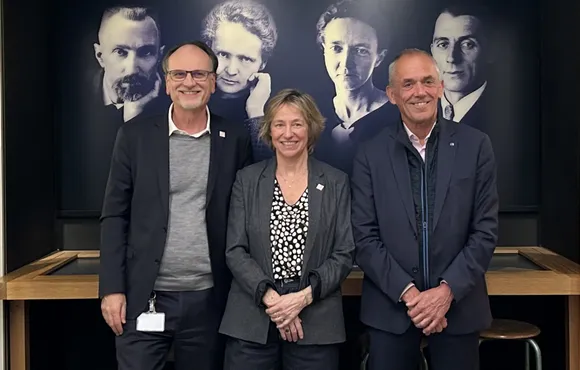- Home >
- Institut Curie News >
- The secret of an essential cell signaling pathway has finally been revealed
Fifteen or so years ago, Christophe Lamaze, head of the Membrane mechanics and dynamics of intracellular signaling team (CNRS UMR3666 / Inserm U1143) at Institut Curie, decided to do an in-depth study of the interferon receptor (IFNAR) and the JAK-STAT signaling pathway:
Interferons and this pathway are essential in several pathologies, including cancer and autoimmune or viral diseases, outlines the researcher. It thus interested immunologists, not cell biologists.
The subject presented a true challenge, however: there are 17 interferons capable of inducing various cell responses... by all binding to the same receptor. “How can different keys going into the same lock lead different ways?”
Most scientists who researched the response concentrated on the cell membrane, but Christophe Lamaze had a different idea: look inside the cell. By studying the EGF (epidermal growth factor) receptor, he had previously demonstrated that a ligand binding to a cell receptor is not always enough to activate a signaling pathway. Sometimes molecules need to enter the endosome, a membrane compartment inside the cell.
Inhibition is suspended in the cell
Using sophisticated imaging techniques, such as high-resolution confocal fluorescence microscopy and FLIM-FRET microscopy, Christophe Lamaze and Cédric Blouin, team researcher, along with their colleagues at Inserm and universities in Osnabrück (Germany) and Liverpool (United Kingdom), revealed that even then, it all happens in the endosome.
In the cell membrane, IFNAR bound to an enzyme (in this case, TYK2) is combined with the STAM protein, which renders it inactive. When interferon alpha binds to it, the receptor, its enzyme and STAM enter a specific area of the endosome. Another protein, called Hrs, then attracts the STAM protein to itself, thus suspending receptor inhibition. This can then activate TYK2, thus triggering the JAK-STAT signaling pathway.
Conversely, when interferon beta binds to IFNAR, it does not go into the same area of the endosome, and activation of the JAK-STAT pathway thus does not depend on the same mechanism. These results have just been published in Nature Cell Biology.
Our work involved IFNAR bound to TYK2 but there are three other enzymes in the JAK family that respond to other cytokines or interleukins and which could follow the same process. For example, in cancer, these signaling pathways are often hyper-activated. Molecules which work inside the cell could be an interesting therapeutic target to reduce their activity.
believes Christophe Lamaze.
Reference : Zanin, N., Viaris de Lesegno, C., Podkalicka, J. et al. STAM and Hrs interact sequentially with IFN-α Receptor to control spatiotemporal JAK–STAT endosomal activation. Nat Cell Biol (2023). https://doi.org/10.1038/s41556-022-01085-6
Vieira, A.V., C. Lamaze, and S.L. Schmid. 1996. Control of EGF receptor signaling by clathrin-mediated endocytosis. Science. 274:2086-2089. doi: 10.1126/science.274.5295.2086.
Research News
Discover all our news
Celebration
The Immunity and Cancer research unit (U932) celebrates its twentieth anniversary
12/12/2025
Artificial Intelligence
08/12/2025


